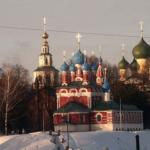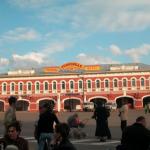Sights Uglich, Russia
 Uglich - the city-monument of history and culture of Russia. Every era has added the names of people whose lives are somehow connected with the fate of the city, with the fate and history of Russia itself.
Uglich - the city-monument of history and culture of Russia. Every era has added the names of people whose lives are somehow connected with the fate of the city, with the fate and history of Russia itself.Center of Uglich, his heart - the Kremlin. Here is a great Savior Transfiguration Cathedral, the most powerful structure of the Kremlin ensemble. Next to him - tridtsatipyatimetrovaya tower with a golden head, which can be seen from anywhere in the city. In 1984, experts Uglich watch factory installed in the bell tower digital watch. Now the city every half hour to hear carillon hourly bells. The cathedral and bell tower were built in 18 century. But the Kremlin has more ancient buildings, which has witnessed dramatic events in the history of our state. From the palace buildings of the Kremlin XV century, only two-story stone building, called the "House of Prince Dimitri" (1482). Although the House restored in the XIX century, they give very accurate representation of the same shape.
Place of death of a minor prince Dimitri was first pointed out a wooden chapel, and then built a wooden church, and in 1692 built a stone church "Demetrius on the Blood", which has reached our days. Its main hall - a tall, two rows of windows, painted by artists of the late XVIII century, reproducing in detail all the events connected with the murder of Dimitri, except one, which tells the exiled the bell. During the investigation into the murder of Prince Bell was found guilty of calling for an uprising Uglich, for which he had his ear cut off, tongue pulled out and he was exiled to the city of Tobolsk. Only at the end of XIX century, disgraced the bell was returned to Uglich.
Stone Cathedral of the Transfiguration Cathedral in the Kremlin was built by Andrey big in 1485, but in 1713 due to dilapidation was pulled to the ground and re-erected. In 1860 the cathedral was made of carved wood gilded iconostasis. Near the cathedral is elegant bell tower (1730), which, being the tallest building in the Kremlin, forms his silhouette, are shown with the Volga and from the city.
On the right side of the Stone creek, on a small hill is visible from afar "Divnaya" Assumption Church (1628) Alekseevskogo monastery. The people not in vain called it "amazing" - unusual trehshatrovoe cover, located on the same line, and just found the proportions give it a sharp, floating in space silhouette.
Sam Alekseevskii monastery was founded in 1371 by Metropolitan of Moscow Alexy. From the buildings of the monastery has been preserved Church of St. John the Baptist (1681) - five-domed cathedral, whose roof was redone in the XIX century.
The part of the Volga architectural appearance Uglich is formed by two more monuments of ancient architecture. This is the Church of the Nativity of John the Baptist (1689-1690 g.) - elegant five domes, with a very beautiful porch and bell-tent, and the Resurrection Monastery.
Resurrection Monastery began to be built stone buildings in 1674 by order of the Rostov Metropolitan Jonah. Holy Resurrection Cathedral, belfry, chambers of the Church of the Virgin of Smolensk - all the monastery buildings, located along one axis, from north to south, stretched and squat, but different height of the buildings as if their balances and complements. This beautiful sculptural ensemble with different points of inspection looks different, its composition seems surprising sound and balanced.
Near the Resurrection Monastery is Epiphany Monastery, which was originally located inside the Kremlin and was placed there in 1661. The main monastery buildings are made in the XIX century, but the best is Smolenskaya church, built in 1700. Closer to the Volga, on the street Narimanov, located Korsunskaya church, built in 1730. At the church, above the dining hall, rises an elegant bell tower.
From residential development Uglich XVIII century preserved a few houses. You can see a two-storey wooden house Voronin (Kamenskaja st., 4) with a beautiful tiled stove; house Kalashnikovs (Pervomaiskaya Str., 13/10), consisting of rock (facing the street) and the wooden parts. An interesting two-storey stone house merchants Ovsyannikov (st. Karl Liebknecht, 14) with the lower ground floor, more than twice as high the second and a wooden plank hipped roof. Two-storey stone buildings of beginning and middle of the XIX century, built up the entire right side of the street. Karl Liebknecht, and Krasnoarmejskij Boulevard, located on the high bank of the Volga. These houses seem to like each other and at the same time, different. This "model" building used for regular development of provincial Russian cities. Provided with the architectural forms of stone house Pereslavtseva (XIX century). As unique wooden log house of fur (II floor. XVIII cent.). This is perhaps the only example of a wooden suburban housing in Russia. Baroque arched aprons decorated mansions Ovsyannikov, Odintsov.
At 12 km from the city (on the road to Rostov), the most valuable monument edge - St. Nicholas Uleyminsky monastery, founded in 1400. The surviving buildings of the monastery ensemble of XVI-XVIII centuries, located in a picturesque location on the river Uleymoy, are admirable.
10 km from the village of Uglich Divnaya Gore is Trinity Church - is the only remaining witness of the projected here by Metropolitan Jonah in 1674 Divnogorsk desert.
City Museum: Museum of evil forces, representing the myths and superstitions of the Russian people. Museum of prison art. Its founder, a famous lawyer in Uglich, gathered it works Volgalaga prisoners.
The museum, which is called - Library of Russian vodka. When the sculptor Ernst Unknown proposed the creation of the world's first monument of Russian vodka, now standing in front of this museum, he responded immediately:: "A very flattered their confidence in such an important and traditionally sensitive to body and soul Russia's state object. The Museum's enormous collection of this sensitive to the Russian soul drink - more than eight hundred varieties, produced in Russia today. This museum arose by chance. It was in Uglich once started the famous Russia vodochnik Peter Arsen'evich Smirnov. Even as a fortress yard Skripitsyn, Pyotr Smirnov started his business, began to produce vodka. In the 19 century in Uglich was open for two vodka factory, and he became a merchant Smirnov third guild. Employees of the museum succeeded in finding several bottles with labels belonging to that time.
Uglich Museum. It was founded in 1892 in the restored Palace, House of feudal princes. The collection includes many unique items, especially in the collections of ancient art. Jonah Leontief rank (ca. 1480) - a magnificent monument of the Moscow School of painting. Smoothness of lines, elongated proportions, a soft noble color - clear signs of the influence of the leading masters of the era - Dionysius. Icons of local craftsmen XVI-XVIII centuries are not so elegant and archaic, but they leave an imprint on the iconography of the Upper Volga region.
